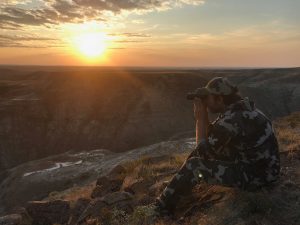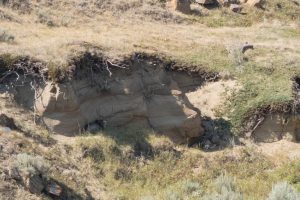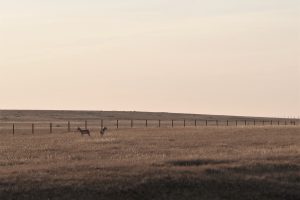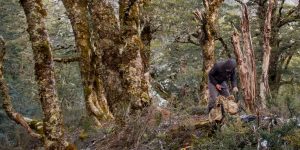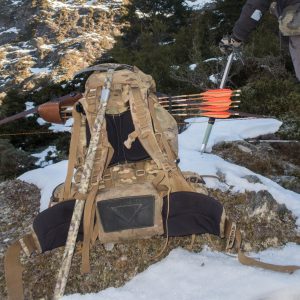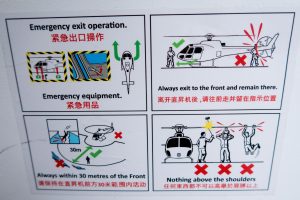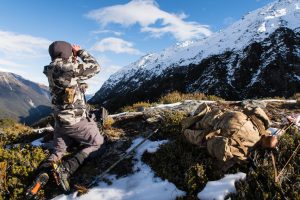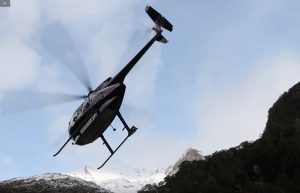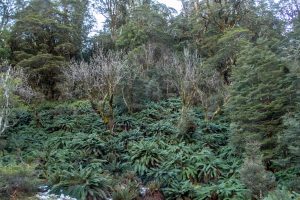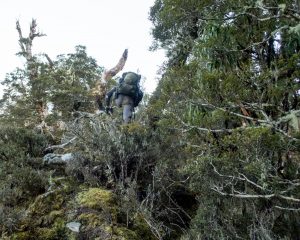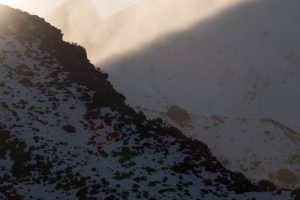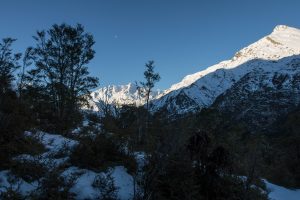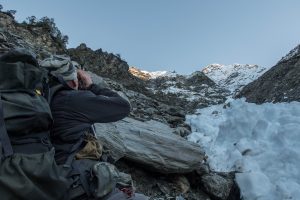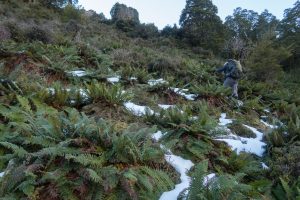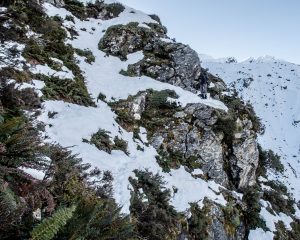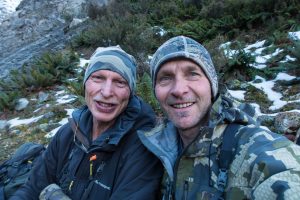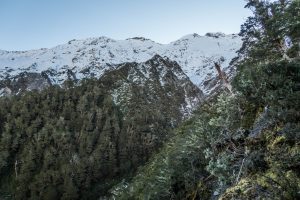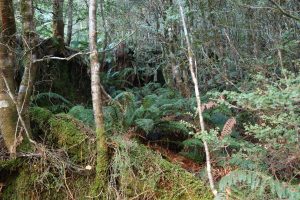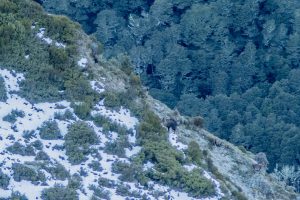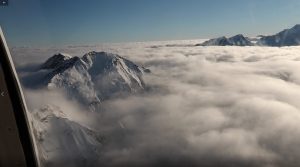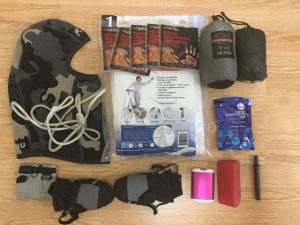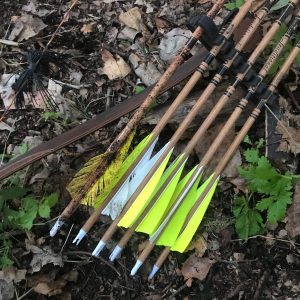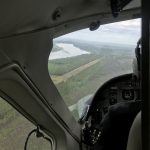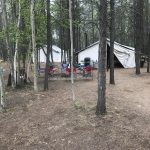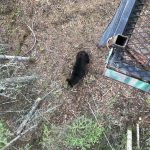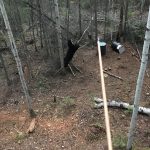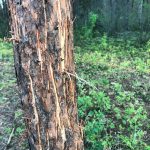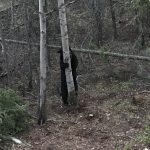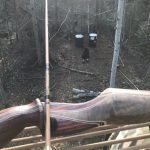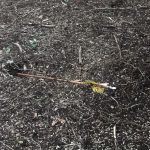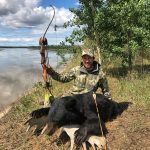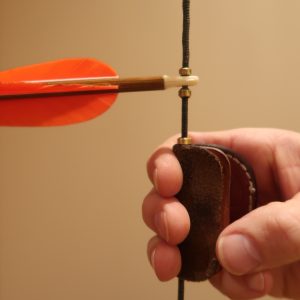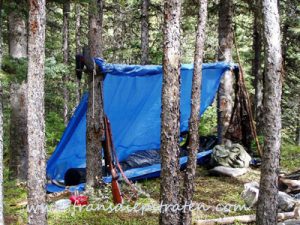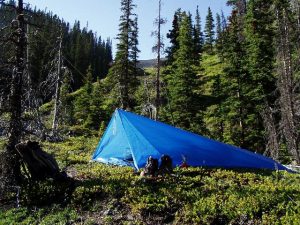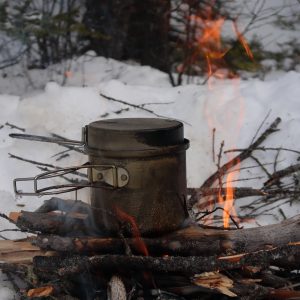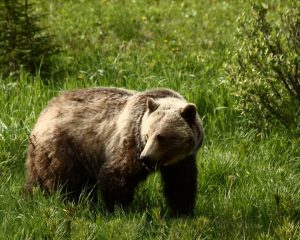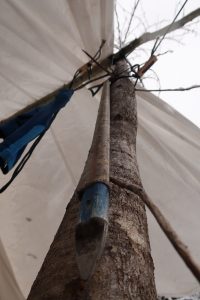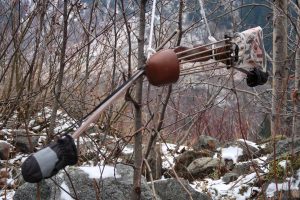Rocky Mountain Goat hunt SE of Kitimat BC
November 2017
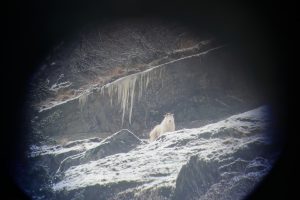
“A Beast the Color of Winter”
Preface
Mountain goat, the “Beast the Color of Winter”, I have been wanting to hunt for a long time. After years of unsuccessful draws in Alberta, and the age-clock ticking, my wife decided I should take the opportunity of a hunt offered to me through a friend, for a late-season hunt in coastal British Columbia. I would be guided by my hunting buddy Kyle, whose goat hunting experience is about the same as mine: negligible to none. When speaking to the outfitter (D.) he assured me that the terrain would be well-suited to bow hunting. Just climb up through the trees till level with the goats, traverse, stalk, shoot. We had a plan!
Pre-hunt days
Less than two weeks before the hunt, messages started pouring in from the field that snow levels were unusually high, access was difficult, climbing possibly impossible or dangerous. We needed to decide if we wanted to push ahead or postpone a year. I would have been OK with the latter, but the second hunter (H.) wanted to wait and see, so we waited and saw, and it turned out that though the access was difficult, the hunting area was still in fair shape, so the hunt was on!
Traveling
A long drive on a Monday brought us to the outfitter’s house, a beautiful log home in the boreal forest. We chatted about the plans, the boat ride in, the state of the trails, and more. After a 2AM wake-up, a five-hour drive, and lowering the boat trailer to where the outboard motor touched water, technology started working against us. The marine battery didn’t start the engine, the battery pack didn’t provide the required power, and the generator wouldn’t start. We were also unable to pull the trailer back out of the water due to the iced-up ramp.
About half an hour of tinkering later, the boat’s outboard motor was puttering; we loaded up and commenced the 60km boat ride. Now, in my opinion, pontoon boats make good vessels, if you are planning on venturing 300 feet from shore, firing up the barbeque, emptying the cooler of beer, and jumping off the roof into the lake. They make some poor load-hauling-big-lake watercraft as we were about the find out. Even small winds make big waves on the open water, and the bowless craft didn’t like those conditions. We took on water, dipping the nose of the craft into a big roller, and had to flee behind an island to get out of the wind.
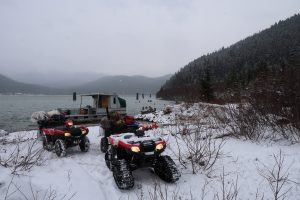
Five hours later, back on dry land
With serious anxiety about the home journey, at least for me, we beached the craft, unloaded, and drove two quads and trailers for of gear to a gorgeous cabin at a smaller lake, where we spent the night. Early next morning, we road about 2 hours on an old road, partially overgrown, to our intended camp site, where some gear had been left after the previous hunt, and some had been ferried over the previous night. Only one wash-out had to be negotiated by portaging our gear, and gingerly feeding the quads and trailers across what real estate the raging waters had not destroyed.
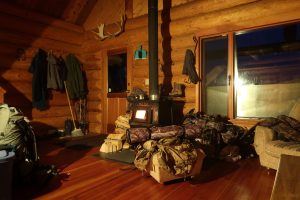
Inside the surprisingly nice cabin
We cut an opening in the alders to fit two wall tents, set up a kitchen, wood stoves, cots, and brought in all the boxes of food and paraphernalia, before venturing out to find a dead tree to turn into firewood.
Hunting Day 1
Setting camp consumed a large chunk of our first hunt day, but we ventured out for the afternoon to spot some goats, which we readily did. Nannies and kids, later joined by two billies. We got our first taste of the toughness of the terrain, as we battled alders at the bottom, steep mossy climbs in the trees, and too-steep-for-comfort grassy rock slopes once past tree line. We never reached those goats and turned around; in fact we weren’t even sure if we were on the right track. But we had seen goats, and spirits were high.
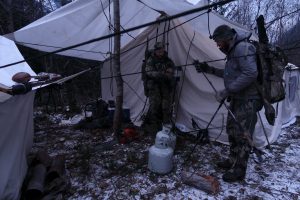
Getting ready to leave
Hunting Day 2
The area we were hunting consisted of a long down-sloping ridge with a mixture of trees and rock on the top, steep cliffs underneath, patches of grassy areas mixed with more cliffs and slab rock, and fingers of tree cover reaching up from the bottom, all of this cut up by avalanche chutes, and creeks that look more like waterfalls, but frozen, due to the early cold weather.
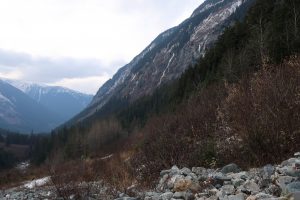
Glimpse of the slopes we’d be hunting
Our daily approach was to fight the alders to the one of washes (creek beds opened-up and cut-deep by rock slides) and glass the slopes. We readily found a group of four goats from the second wash, running up and down a patch of green, chasing, cajoling, rutting. Before we could make up our minds to go after them, or even figure out in our minds where we would start the climb, they were gone. In the afternoon, we climbed up the wash and through a treed area, attempting to lay eyes on a small basin, and a possible route to even higher trees, only to get stuck in a forest of alders. We hadn’t climbed high enough, and were starting to feel some apprehension about the terrain, and the feasibility of true spot and stalk hunting.
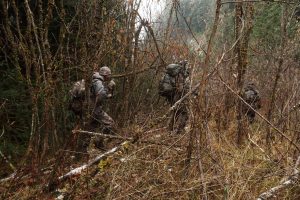
Fighting the alders, every day, twice a day
We made it to the tent just before D. returned with his hunter, the latter hobbling in in less-than-perfect condition. Turned out he had slipped and fell, bouncing down fifty feet of rocks, dropping off a ten-foot cliff and stopping just before a 200-foot cliff that would have killed him. His rifle didn’t survive the ordeal; stock broken it careened off the mountain, never to be retrieved.
Hunting Day 3
Amazingly, despite a bruise that covered his entire leg from hip to foot, a badly hurting heel and swollen arm H. was ready to go after breakfast. Tough kid! The four of us hiked up together to the very edge of the trees, where they petered out into some alder shrubs. D. suggested hiking up higher to another group of trees to keep watch on some nannies from there. I hesitated because of the terrain. Not much later a billy showed up and we made the climb anyway. I don’t recall if I had already mentally given up on the longbow by then, because we were climbing into a dead end, with no chance for a bow shot. I didn’t matter, cause the billy spooked. Don’t they say that you cannot approach them from below? We proved that statement correct. This billy also showed nothing of the phlegmatic attitude that D. had found these goats to have; he was not enjoying us crawling around on his front porch and took off.
We climbed back down and glassed for a while without seeing anything of interest. A long walk back it was, through the water and snow-covered alders. I slipped while crossing a rock slide, the bow string got pushed into a sharp edge, and shredded four or five of the fifteen strands. Soaked we got to the tents, lit a fire, ate a meal, went to bed, but not before I, with a heavy heart, took the longbow apart and put it away for the rest of the hunt. If I was going to kill a billy, it would have to be with a rifle. A better man than me might have pulled it off, but basically there were only one or two very specific locations where an approach to within bow range might have been possible, but chances of that becoming a reality were slim to none.
Hunting Day 4
With a new outlook on the hunt, Kyle and I took off in the pre-dawn, while D. and his hunter went out to go collect more firewood. We spotted goats in one location that we couldn’t reach earlier, two nannies and a kid and a fourth one we could not identify. We decided to climb elsewhere, had lunch underneath a gorgeous clearing that practically reeked of goat, and continued to climb to the tree line. Climb, climb, climb, everything goes up, and when it doesn’t go up it is covered by alders. Thank goodness for the predominant absence of Devil’s Club, we only found it here and there. The mixed cedar/pine forest was beautiful. Spooky almost, quiet, tall, moss-covered, the few lingering patches of fog giving it a touch of the magical. Giant trees, we tried to measure one by embracing the trunk; we were short at least one person, hinting at an 18-foot circumference close to the base.
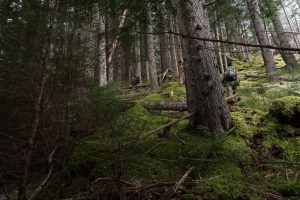
Climbing through the green
We were feeling good and strong, starting to get accustomed to the steepness, climbing steadily. I almost stepped into an avalanche chute when Kyle hissed me back. He had spotted the head of a nanny, on a bench almost straight above, or so it felt. We had decided before taking off in the morning that the more effective way of hunting here was to climb to the goats’ home turf, and wait for them to show, rather than to spot them from below and then spend a few hours climbing to find them gone.
We did just that and were rewarded. As I started to climb a little higher to see if we had line of sight to a group of four goats further up the ridge that we had spotted earlier Kyle again hissed me back. “Billy!!” I slid into the chute and clambered to find a shooting position, while the billy retreated out of sight. Shooting would be about 45-50 degrees up from the horizontal, and it took some fiddling and body contortion to find a rest.
My support hand needed to be under the trigger guard to get the required elevation, but my body was hugging the slope and I had a solid rest for my right arm. Relaxing, breathing, closing eyes, opening, natural alignment, this could work. Kyle brought me my pack, which was useless for support as it wouldn’t sit on the steep slope, and my rain jacket, as I was getting wet. I settled in. Not for long. Five minutes, maybe or ten. Two goats appeared on the bench further towards the right. A slight adjustment of the position, confirmation through the spotter: “The one on the right!” Natural alignment, sort of, breathe, a spot low on the chest of the quartering away goat, squeeze.
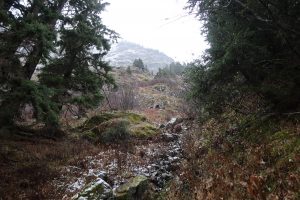
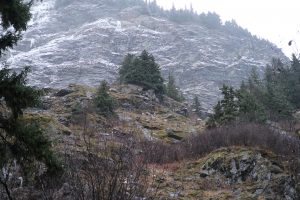
The billy was just to the right of the clump of trees in the centre
“You got him!!” I didn’t see the hit. Four seconds later I saw the goat fall off the small cliff, head first, legs up, dead. Not much later there was a brief sound of rock fall to our right. Did he slide all the way there? We looked but saw no sign. We decided to climb up and see where he fell, there were a few hours of day light left, and the approach looked steep but manageable. We were wrong. Quickly after we left the last trees and used the last alders for support in our quest for the high bench things got a little too hairy for our taste, with all the rain that had fallen that day. We tried a different route but got cliffed out. Back to the first route, a slightly different approach, but we again found a traverse that was too sketchy. One four-foot step was all it took to get across a piece of slab rock but the departure and arrival rock were wet and covered with a thin layer of snotty moss without proper handholds. Looking down we saw nothing but thin air and the tops of the trees below. We couldn’t even see the rocks that would split open our skulls should we slip. We retreated for the day to bring back the outfitter in the morning. Good thing we did, I think we would have spent the night up there had we pushed on and somehow not killed ourselves. We still came into the tent well after dark.
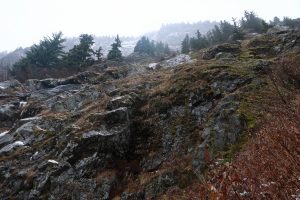
Slip and you die
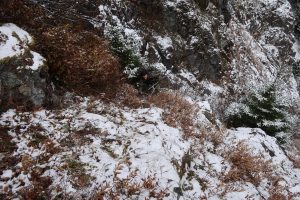
Gnarly steep, still trying to get to where we hoped we would find the goat
Hunting Day 5
Four goats were hanging out close to where we were the night before. I wanted to scout the lower stretch of the creek, but D. wanted to stick to the trees so as not to spook the goats. With some reluctance, I agreed. We climbed to the crux, and Derrick managed to get across with some maneuvering that was hard to watch. He eventually made it to where the billy had been standing and was able to look into the area where the goat fell, but didn’t find anything. He directed us to where he figured the goat might have rolled or slid, and we looked into every crevasse that we could access, while he and H., who was going as if nothing had happened to him, worked the other side. We came up empty.
After we had exhausted ourselves, we started to traverse back through the trees with hanging heads. Kyle picked up a sound, and figured maybe the other guys were coming down. We stopped, and were about to yell at them when like silent ghosts a dark-chocolate coloured sow grizz (or should I call them brown bear this close to the coast) and her almost adult cub emerged from the trees. At first it seemed like they would continue their walk, but they must have heard or seen or smelled something because as quickly as their backside had disappeared, their inquisitive heads popped out at the edge of a gully across from us, probably no more than 200- 250 feet away. As we maintained our silence, the sow grew bolder and stepped up. It was time we made our presence known. Our yelling and banging of my ice axe against a tree did stop her approach, but it did nothing to expedite her departure, so I decided a slow retreat on our part was the way to go. By the way, this was the first day in a long time Kyle had decided to leave his bear spray off his pack; mine was at the ready.
It was a very silent walk back to the tents that night, and I watched that billy fall dozens of more times during a very restless night.
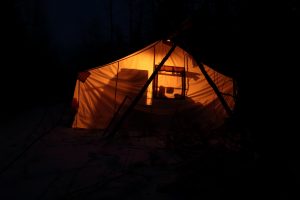
Dark night
Hunting Day 6
Kyle and I spent the day in camp, reading, talking, thinking, while D. and the other hunter took my rifle out for a walk. We split wood, cooked dinner, rested. I went out for a bit to look for goats, and maybe, through some stroke of luck, see circling ravens to indicate where my goat might have fallen.
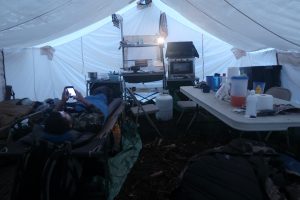
Rest day
Hunting Day 7
I had planned to look through one more section of mountain, and especially look again for congregation of birds, to see if we at least could get some closure to the matter of the lost billy, however, the weather forecast was such that D. wanted to leave for the cabin that afternoon instead. We would forfeit the final hunt day and most of the second to last day, in favour of hopefully decent boating conditions. D. and his hunter went out for a quick look at the slopes, while Kyle and I packaged the contents of the cook tent, loaded it on two trailers and hauled it back to where a portage of goods would be necessary. With the snow at the higher elevation, the wheeled quad barely made it. After unloading, the left rear track spun off the wheels of the tracked quad, leaving one of the two quads non-functional, with two hunters, the remainder of camp and the tools required for the repair at least 15 km down the trail. We rode back, packed camp in one trailer, and collected the two other guys who rode on top of the load in the trailer. The wheeled quad, now with tire chains, struggled, but got us there.
Traveling once more
After the real Canadians ate Kraft Dinner and I ate a Heather’s Choice meal, we had turned in early the previous night, to allow for a 4am wake up. We were ready to set sail by 6:30, half an hour before first light. We couldn’t load everything in one go, so the plan was to drop Kyle and me, plus two quads, a chainsaw and some fuel off at a little beach about half way. An old mining road started not too far from there, we just had to cut our way through the trees to reach a two-track trail connecting a bunch of camp sites, which would lead us to the start of said road. Our ride would cover an unknown distance, but we estimated at least 40 km.
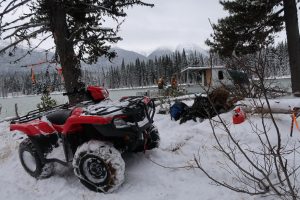
Dropped off
Just as we cut the last tree, the chain came off the saw. We managed to get the quads and one trailer out to the two-track trail with a lot of lifting and shoving on the rear end of the tracked quad, and hand-pushing the trailer. With some relieve we started our long ride out, but were blocked unceremoniously by more fallen trees; big ones. No way through. It turned out that in the summer the trail had been clear but D. had not been there since. A storm had done its work.
We shot Derrick an InReach message that we could not make it out. I vetoed his initial suggestions to drop off the other saw on this way through, so we could still cut our way to the road. The chains on his saws had seen better days ; it was more by friction than by cutting that we downed trees. Moreover, there was no telling how many more trees we would encounter. It was more than likely we would not make it out that night, or at all.
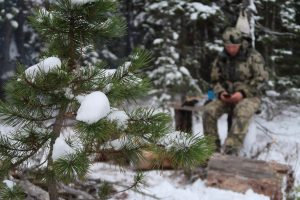
Reaching out, arranging our extraction
Therefore, we jumped on board as he came by, abandoning the quads for a pick-up the next day, and made it to port as the last shimmers of daylight disappeared.
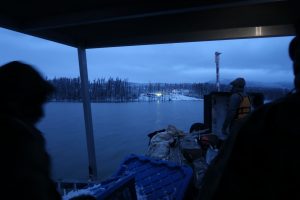
Pulling in at last light
After we had pulled into a motel the night before earlier than we had wanted, due to the road conditions, we had a long drive to get home. The road through Jasper and Banff National Park was beautiful as always, but snow and ice covered, making for slow going. Kyle had to tack on another three hours, after I dropped onto the couch and cracked my first beer in ten days.
Epilogue
“Try to keep a positive and flexible attitude” a friend told me before I left. We tried, we hunted hard, stepped outside of our comfort zones on the slopes, and created a chance, even though it was not with the longbow. Maybe the mountain resented my lack of resolve and decided to keep the goat for itself.
We hunt for the experience, we say, and at the end of a long day of scaling slopes and crags looking for the goat, I would have gladly given away meat, horns and hide, in return for getting closure. The sense of waste was great, but nature will see it differently. Likely the bears found the goat, and used it to beef up their calorie intake right before hibernation. Ravens and other birds happily ate the scraps, and smaller predators and rodents will gnaw on the bones. Next spring, the melting snow and rains will wash whatever remains of the goat down to the creek, erasing the last reminder of our hunt from the steep slopes.
FD
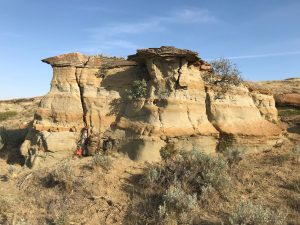 After last year’s mule deer hunt had been full of blunders and bad luck, we were pretty keen on getting back out and redeeming ourselves. Kyle had his sights set on a decent velvet buck, and I was going to uphold my usual standards: anything legal is fair game, unless I don’t feel it when the situation arises.
After last year’s mule deer hunt had been full of blunders and bad luck, we were pretty keen on getting back out and redeeming ourselves. Kyle had his sights set on a decent velvet buck, and I was going to uphold my usual standards: anything legal is fair game, unless I don’t feel it when the situation arises.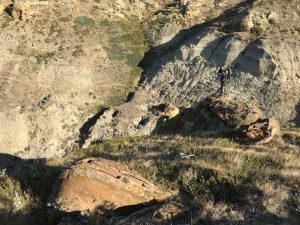 Kyle trying hard not to skyline himself
Kyle trying hard not to skyline himself